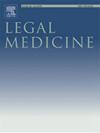液相色谱-串联质谱法测定死后干血斑样品中多种精神兴奋剂和抗精神病药物
IF 1.3
4区 医学
Q3 MEDICINE, LEGAL
引用次数: 0
摘要
在法医实践中处理精神兴奋剂和抗精神病药物中毒死亡时,检测和准确量化致病药物对于明确诊断至关重要。如果死后的变化导致血液中存在各种掺杂物,市售的简单筛查试剂盒可能会产生假阳性。在本研究中,我们着重于应用干血斑(DBS)样本,为中毒死亡相关药物的法医毒理学分析开发一种简单、准确的方法。为了验证我们的新分析方法,我们使用液相色谱联用电喷雾电离串联质谱法定量了尸体DBS样品中的两种精神兴奋剂(安非他明、甲基苯丙胺)和八种抗精神病药物(氯丙嗪、氟哌啶醇、左旋丙嗪、阿立哌唑、氯氮平、喹硫平、利培酮和帕利哌酮)。在0.05 ~ 1.0 μg/mL范围内,校准曲线线性良好。该方法可重复准确地定量10种靶药,测定内变异系数小于10.6%,测定间变异系数小于12.4%。此外,在DBSs中- 80°C保存的所有药物浓度在至少2周内几乎保持稳定。与我们的常规方法(称为QuEChERS)比较,所有药物的可量化浓度均呈良好的正相关。此外,对于所有药物,DBS法得到的浓度与QuEChERS法得到的浓度几乎完全一致。本文章由计算机程序翻译,如有差异,请以英文原文为准。
Determination of multiple psychostimulants and antipsychotics in postmortem dried blood spot samples by liquid chromatography–tandem mass spectrometry
When dealing with psychostimulant and antipsychotic poisoning deaths in forensic practice, detection and accurate quantification of the causative drug are essential for a definitive diagnosis. If post-mortem changes have resulted in the presence of various adulterants in the blood, commercially available simple screening kits may produce false positives. In this study, we focused on applying dried blood spot (DBS) samples to develop a simple and accurate method for forensic toxicological analysis of drugs of interest in poisoning deaths.
To test our novel analytical method we used liquid chromatography coupled with electrospray ionization−tandem mass spectrometry to quantify two psychostimulants (amphetamine, methamphetamine) and eight antipsychotics (chlorpromazine, haloperidol, levomepromazine, aripiprazole, clozapine, quetiapine, risperidone, and paliperidone) in cadaveric DBS samples. The linearities of the calibration curves were good in the concentration range of 0.05–1.0 μg/mL. The method allowed for repeatable and accurate quantification of the 10 target drugs with intra- and inter-assay coefficients of variation of below 10.6 % and 12.4 %, respectively. In addition, the concentrations of all drugs stored at −80 °C in DBSs remained almost stable for at least 2 weeks. Comparison with our general practice method (known as QuEChERS) showed good positive correlations of the quantifiable concentrations of all drugs. In addition, for all drugs, the concentrations obtained by the DBS method were almost well coincident with those obtained by the QuEChERS method.
求助全文
通过发布文献求助,成功后即可免费获取论文全文。
去求助
来源期刊

Legal Medicine
Nursing-Issues, Ethics and Legal Aspects
CiteScore
2.80
自引率
6.70%
发文量
119
审稿时长
7.9 weeks
期刊介绍:
Legal Medicine provides an international forum for the publication of original articles, reviews and correspondence on subjects that cover practical and theoretical areas of interest relating to the wide range of legal medicine.
Subjects covered include forensic pathology, toxicology, odontology, anthropology, criminalistics, immunochemistry, hemogenetics and forensic aspects of biological science with emphasis on DNA analysis and molecular biology. Submissions dealing with medicolegal problems such as malpractice, insurance, child abuse or ethics in medical practice are also acceptable.
 求助内容:
求助内容: 应助结果提醒方式:
应助结果提醒方式:


